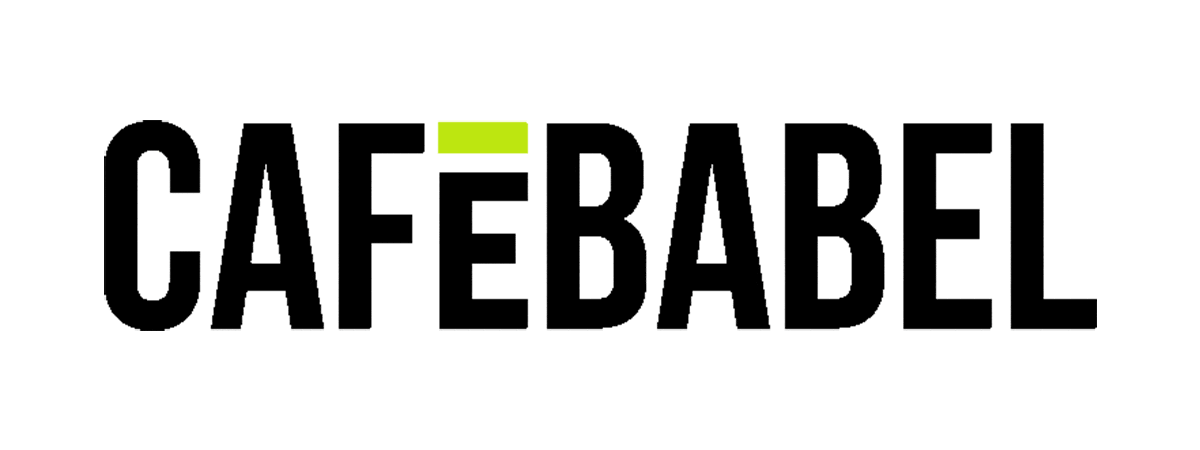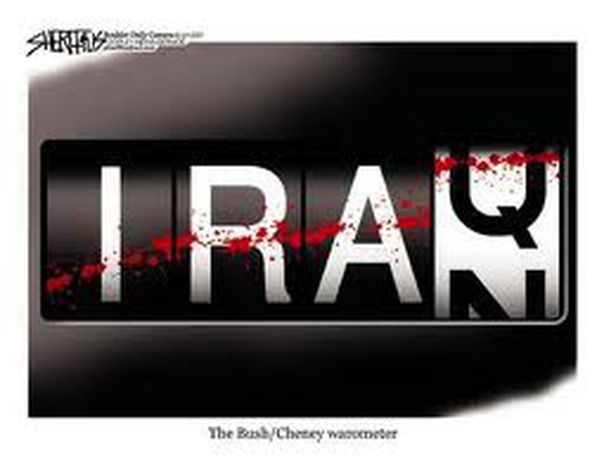
End Game Approaches on Nuclear Iran
Published on
From the start of 2012 the spotlight on Iran and for good reason. Today the entire region is now on tenterhooks for the next move, with US, Iranian and Gulf armies on the highest war alert. Earlier the main scenario was that Israel would make an preventive limited air strike to Iran's nuclear facilities, now it seems that U.S is going to war with Iran.
The decision point for applying a military option, before too late, is getting nearer. Ehud Barak, Israel’s minister of defense, implied that this critical point would be reached in less than a year, in a recent CNN interview. U.S has changed radically its earlier position, now both the U.S. and Israel say also officially that they have not ruled out military action against Iran. This in case if diplomacy fails to resolve a dispute over the nuclear program, which Tehran says is peaceful but the West believes is a cover for trying to build atomic bombs. The use of military option is now well on the way.
Latest developments
Thousands of US troops began descending on Israel this week as part of the US-IDF deployment in readiness for a military engagement with Iran and its possible escalation into a regional conflict. The 9,000 US servicemen gathering in Israel in the coming weeks are mostly airmen, missile interceptor teams, marines, seamen, technicians and intelligence officers. Officially this maneuver is part in sc Austere Challenge 12, the biggest joint US-Israeli war game ever held. The joint US-Israeli drill will test multiple Israeli and US air defense systems against incoming missiles and rockets, according to the official communique; they will also practice intercepting missiles and rockets coming in from Syria, Hizbollah in Lebanon and Hamas in the Gaza Strip. In fact the joint force will now be in place ready for a decision to attack Iran's nuclear installations or any war emergency. Washington and Jerusalem are doing their utmost to present a perfectly synchronized military front against Iran: American officers are stationed at IDF command centers and Israeli officers posted at the US European Command-EUCOM.
Washington and Jerusalem are doing their utmost to present a perfectly synchronized military front against Iran: American officers are stationed at IDF command centers and Israeli officers posted at the US European Command-EUCOM. British Defense Minister Phillip Hammond, on a visit to Washington, affirmed unofficially that Britain stands ready to strike Iran if the Strait of Hormuz is closed. Officially this was not said as the Obama administration tries keep a low profile on plans for attacking Iran.
 Tehran
is staging military's maneuvers every few days to assuring the Iranian
people that its leaders are fully prepared to defend the country against
an American or Israeli strike on its national nuclear program. By this
strategy, Iran's ground, sea and air forces are maintained constantly at
top war readiness to thwart any surprise attack. The next Iranian naval
exercise at the Strait of Hormuz to take place in February, although
its 10-day drill in the same arena only ended Monday, 2. Jan. 2012.
Iranian marine commandos were preparing to sow mines in the strategic
Strait of Hormuz. Other – last week tested – possibility was using
Shahab-3 ballistic missiles which have a range of 1,600 kilometers and
other missiles, such as the Nasr1 cruise marine missile, are capable of
reaching Hormuz from central Iran. Tehran has also redistributed the
Shahab missiles to secret sites ready to launch retaliatory strikes.
Tehran
is staging military's maneuvers every few days to assuring the Iranian
people that its leaders are fully prepared to defend the country against
an American or Israeli strike on its national nuclear program. By this
strategy, Iran's ground, sea and air forces are maintained constantly at
top war readiness to thwart any surprise attack. The next Iranian naval
exercise at the Strait of Hormuz to take place in February, although
its 10-day drill in the same arena only ended Monday, 2. Jan. 2012.
Iranian marine commandos were preparing to sow mines in the strategic
Strait of Hormuz. Other – last week tested – possibility was using
Shahab-3 ballistic missiles which have a range of 1,600 kilometers and
other missiles, such as the Nasr1 cruise marine missile, are capable of
reaching Hormuz from central Iran. Tehran has also redistributed the
Shahab missiles to secret sites ready to launch retaliatory strikes.
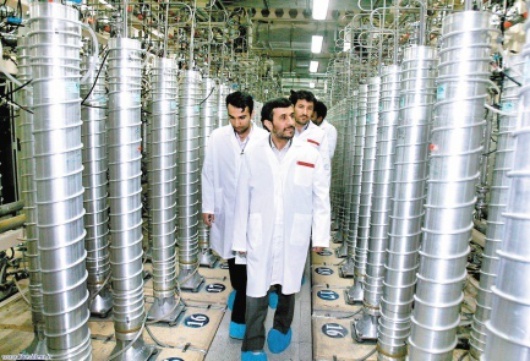 Iran itself has reported that the
new Fordow nuclear enrichment plant will be operational in the near
future to refine uranium to a fissile purity of 20% - far more than the
3.5% level usually required to power nuclear energy plants. 20 % uranium
can be turned more easily into fissile warhead material. Based to
information of the International Atomic Energy Agency inspection 348
machines are operating at Fordow. Operations at the bunker-like Fordow
facility south of Tehran are small in comparison to Iran’s main
enrichment site in Natanz in central Iran, where nearly 8,000
centrifuges are operating. The centrifuges at the underground labs are
considered more efficient than others and are shielded from aerial
surveillance and protected against airstrikes by up to 300 feet (90
meters) of mountain rock. Iran
has also announced that it had succeeded in producing and testing its
own uranium fuel rods for use in its nuclear power plants. If true, this
claim would constitute a significant advance in Iran’s efforts to
attain the capability of powering its nuclear reactors without
international assistance.
Iran itself has reported that the
new Fordow nuclear enrichment plant will be operational in the near
future to refine uranium to a fissile purity of 20% - far more than the
3.5% level usually required to power nuclear energy plants. 20 % uranium
can be turned more easily into fissile warhead material. Based to
information of the International Atomic Energy Agency inspection 348
machines are operating at Fordow. Operations at the bunker-like Fordow
facility south of Tehran are small in comparison to Iran’s main
enrichment site in Natanz in central Iran, where nearly 8,000
centrifuges are operating. The centrifuges at the underground labs are
considered more efficient than others and are shielded from aerial
surveillance and protected against airstrikes by up to 300 feet (90
meters) of mountain rock. Iran
has also announced that it had succeeded in producing and testing its
own uranium fuel rods for use in its nuclear power plants. If true, this
claim would constitute a significant advance in Iran’s efforts to
attain the capability of powering its nuclear reactors without
international assistance.
Military option on the table
The starting point with today's tensions could be the interview in a CBS Tuesday, Dec. 20 where US Secretary of Defense Leon Panetta said following: "Despite the efforts to disrupt the Iranian nuclear program, they have reached a point where they can assemble a bomb in a year or potentially less". This is a radical change in US administration policy. "That's a red line for us and that's a red line, obviously, for the Israelis," Panetta noted. Instead of warning Israel against striking Iran, he said: "If we have to do it we will deal with it."A nuclear weapon in Iran is unacceptable”.
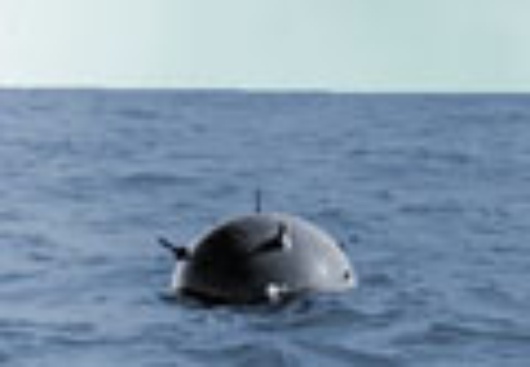 From
Tehran's standpoint, the American military departure from Iraq has
removed a formidable obstacle in Israel's path to an attack on its
nuclear installations: the shield of the US Air Force's control of Iraqi
skies.
From
Tehran's standpoint, the American military departure from Iraq has
removed a formidable obstacle in Israel's path to an attack on its
nuclear installations: the shield of the US Air Force's control of Iraqi
skies.
Gen. Martin Dempsey, Chairman of the Joint US Chiefs of Staff, issued a warning: "Iran is playing a dangerous game that could ensnare the Middle East, the Middle East and others into conflict and a renewed arms race.Don't push it." He was described as quietly leading the ongoing military planning for an attack against Iran's nuclear weapons if the president gives the order to do so. Gen. Dempsey went on to say: "My biggest worry is they (Iran) will miscalculate our resolve. One factor is also Israel which destroyed Syria's nuclear plant in Osirak on 1981 without warning US beforehand. ”There is no guarantee that Israel will give the United States warning if it decides to attack Iran,” Dempsey said. "We are trying to establish some confidence on the part of the Israelis that we recognize their concerns and are collaborating with them on addressing them."
Covert activities
Covert activities against Iran have included the use of computer worms to attack Iran's nuclear installations, including the Stuxnet virus that in 2010 was thought to have destroyed more than a thousand of Iran's uranium-enriching centrifuges by causing them to spin out of control. Several Iranian nuclear scientists have been assassinated, and in November explosions ripped through the Islamic Revolutionary Guard Corps' ballistic missile base near Tehran. Seventeen people were killed, including one of the IRGC's top officers in the missile development program.
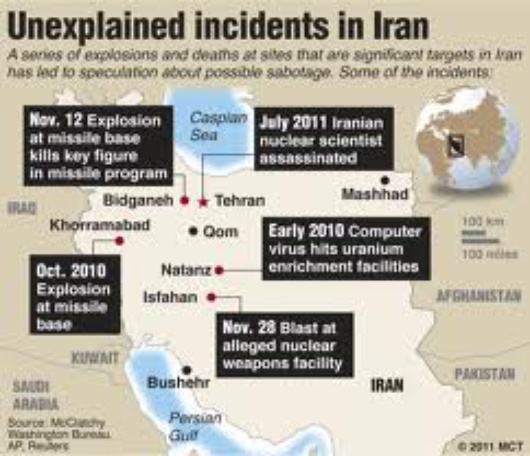 The
covert activity is designed to slow Iran's nuclear progress but they
are not stopping Iran's enrichment activity permanently. Iran is thought
to have many more nuclear scientists and missile designers than Western
intelligence services could ever eliminate.
The
covert activity is designed to slow Iran's nuclear progress but they
are not stopping Iran's enrichment activity permanently. Iran is thought
to have many more nuclear scientists and missile designers than Western
intelligence services could ever eliminate.
In October, the Obama administration accused Iran of plotting to assassinate the Saudi ambassador to Washington, an alleged plot that some Iran analysts see as an Iranian effort to hit back. The storming of Britain's Embassy in Tehran in late November and a December explosion outside Britain's Embassy in Bahrain may be other signals of Iran's intention to respond to covert fire.
The Strike
According to reports in Haaretz and Ynetnews 29.12.11, Israel and the United States have recently been discussing ‘red lines’ which would necessitate a military strike on Iran’s nuclear facilities. US administration is keen to avoid Israel surprising the US by taking unexpected military action against Iran in the coming year. Scenarios, in which Washington might find a military strike against Iranian nuclear facilities necessary, include e.g. if Iran were to expel IAEA observers, if it were to enrich uranium to weapons grade, and if it were to install advanced centrifuges in its newly constructed underground uranium enrichment facility in Qom or Iran making progress on new secret enrichment facilities.
The U.S. Air Force has unveiled the Massive Ordnance Penetrator - dubbed the Big Blu - and speculation is already mounting that it may be used in airstrikes on Iran (as well on North Korea if needed). B-2 Stealth Bombers will use the six metre long GPS guided rocket, fitted with 2.5 tons of explosives, to smash open underground bunkers and tunnels suspected of containing weapons of mass destruction.
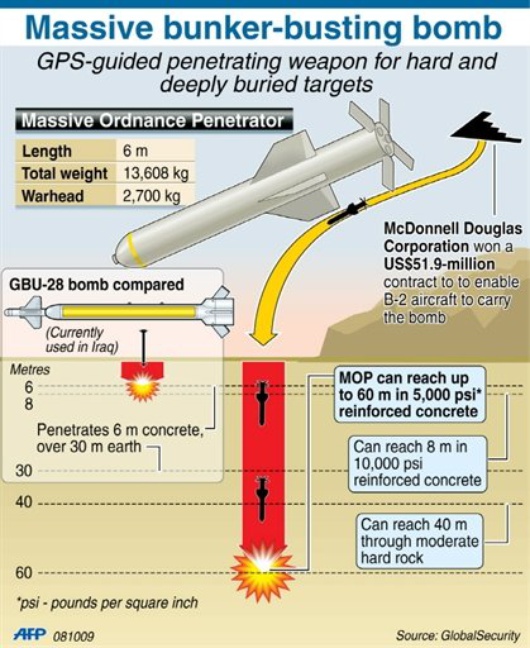 To
be a successful military strike, Iran must be deterred and prevented
from rebuilding its programme. Is this possible is the question and will
define the scope of attack.
To
be a successful military strike, Iran must be deterred and prevented
from rebuilding its programme. Is this possible is the question and will
define the scope of attack.
Counter acts?
In response to mounting Western pressure over its nuclear ambitions, Iran started a naval drill in the Gulf last week , responded with belligerent rhetoric, spooking oil markets by warning that it could shut the Strait of Hormuz if sanctions were imposed on its oil exports, the country's main revenue source. However if Hormuz will be closed by mines, the U.S using mine countermeasures can reopen Hormuz within 24-48 hours.
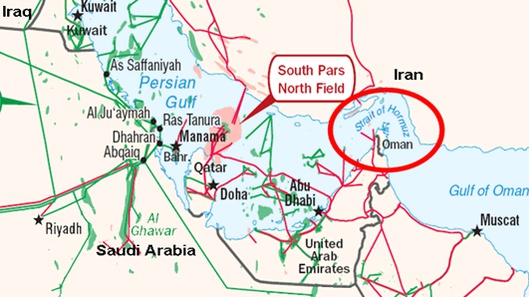 The
Strait of Hormuz is one of the world’s most important waterways. Some
40% of all seaborne oil passes through this narrow passageway, which is
equivalent to about 20% of total oil traded worldwide. This amounts to
16.5 to 17 million barrels per day (other significant choke-points for
the transit of oil include the Suez Canal - 4.5 million barrels per day
and the Strait of Malacca - 15 million barrels per day).
The
Strait of Hormuz is one of the world’s most important waterways. Some
40% of all seaborne oil passes through this narrow passageway, which is
equivalent to about 20% of total oil traded worldwide. This amounts to
16.5 to 17 million barrels per day (other significant choke-points for
the transit of oil include the Suez Canal - 4.5 million barrels per day
and the Strait of Malacca - 15 million barrels per day).
 Israel
has no influence over internal events in Syria or Lebanon. Its interest
is in a quiet northern border. For as long as Hezbollah is able to
maintain its independent military infrastructure in Lebanon, the threat
of an attack on Israel remains. Hezbollah has extensively rearmed after
the losses it incurred in the 2006 Second Lebanon War. It is now
estimated to have an arsenal of 40,000 rockets, including precision
guided missiles that can reach all parts of Israel. It has also
deliberately deployed its weapons in villages to make them harder for
Israel to target in any future conflict due civilian/collateral damages
which would damage Israel's image even more if possible.
Israel
has no influence over internal events in Syria or Lebanon. Its interest
is in a quiet northern border. For as long as Hezbollah is able to
maintain its independent military infrastructure in Lebanon, the threat
of an attack on Israel remains. Hezbollah has extensively rearmed after
the losses it incurred in the 2006 Second Lebanon War. It is now
estimated to have an arsenal of 40,000 rockets, including precision
guided missiles that can reach all parts of Israel. It has also
deliberately deployed its weapons in villages to make them harder for
Israel to target in any future conflict due civilian/collateral damages
which would damage Israel's image even more if possible.
On 7 July, Israel Defense Forces revealed, in unprecedented detail, previously classified information about Hezbollah’s deployment in south Lebanon. The information released focused on El Khiam, a Shia town in south east Lebanon a few miles from the border with Israel. El Khiam was the scene of fighting during the 2006 war; the surrounding area was used by Hezbollah to launch Katyusha rockets at Israel. The IDF material included maps and a 3D simulated video of the village, showing that weaponry and rockets were being stored close to schools, hospitals and residential buildings.
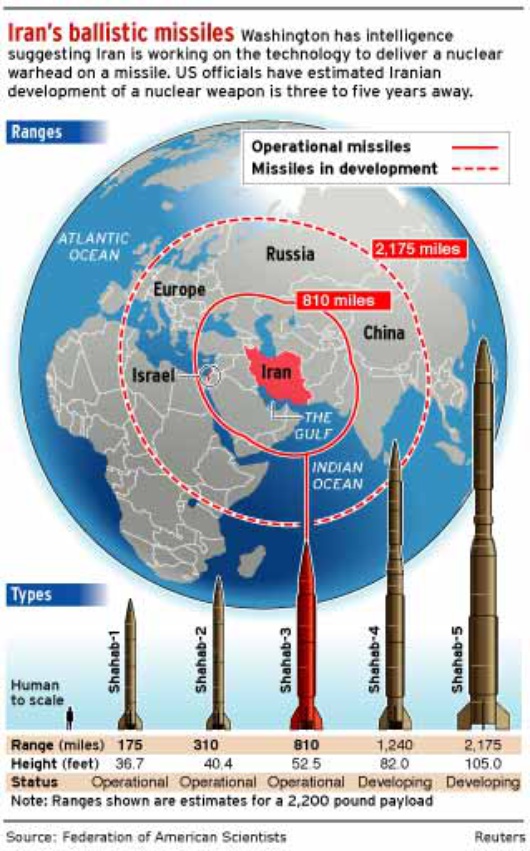 A
military strike can have serious strategic consequences too. Iran will
surely respond violently, both directly and through proxies such as
Hezbollah. Iran has long-range missile systems including the Shahab-3,
which could reach Israel and U.S. bases in the Middle East. The conflict
could escalate into a regional war. Iran may take aggressive action in
the straits of Hormuz, leading to a spike in oil prices, even though
disrupting the flow of oil would be self-defeating.
A
military strike can have serious strategic consequences too. Iran will
surely respond violently, both directly and through proxies such as
Hezbollah. Iran has long-range missile systems including the Shahab-3,
which could reach Israel and U.S. bases in the Middle East. The conflict
could escalate into a regional war. Iran may take aggressive action in
the straits of Hormuz, leading to a spike in oil prices, even though
disrupting the flow of oil would be self-defeating.
Preparations for counter strike
The Magic Wand by Rafael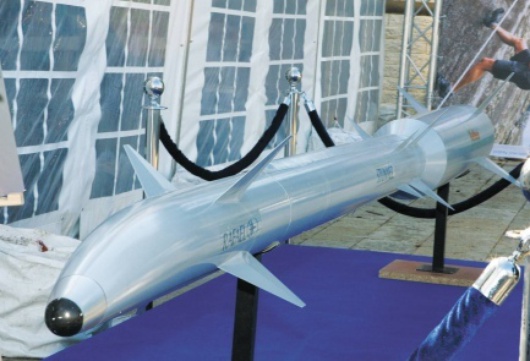
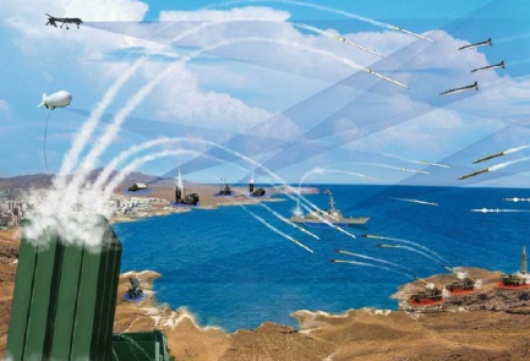 Israeli
defense technology developer Rafael last week unveiled its medium-range
missile interceptor, the Magic Wand, designed to shoot incoming
missiles and rockets out of the sky with its own guided projectile. The
Magic Wand is seen as a possible defense against Lebanon-based terrorist
group Hezbollah's stockpile of medium-range missiles. Magic Wand's
first operational test is expected to take place this Spring. Israel has
– after Magic Wand - three different kinds of interceptors to provide a
shield against a multitude of missile threats. Iron Dome to shoot down
short-range rockets such as the Qassams fired by Hamas in the Gaza
Strip, older Arrow 2 anti-ballistic missile provides defenses against
larger ballistic missiles, such as Scuds or Iran's long-range Shahab
missiles. Testing full operational capacity of newer Arrow 3 interceptor
is ongoing. ( More about Israeli missile defence in article Will Iron Dome balance the Hamas Terror? . )
Israeli
defense technology developer Rafael last week unveiled its medium-range
missile interceptor, the Magic Wand, designed to shoot incoming
missiles and rockets out of the sky with its own guided projectile. The
Magic Wand is seen as a possible defense against Lebanon-based terrorist
group Hezbollah's stockpile of medium-range missiles. Magic Wand's
first operational test is expected to take place this Spring. Israel has
– after Magic Wand - three different kinds of interceptors to provide a
shield against a multitude of missile threats. Iron Dome to shoot down
short-range rockets such as the Qassams fired by Hamas in the Gaza
Strip, older Arrow 2 anti-ballistic missile provides defenses against
larger ballistic missiles, such as Scuds or Iran's long-range Shahab
missiles. Testing full operational capacity of newer Arrow 3 interceptor
is ongoing. ( More about Israeli missile defence in article Will Iron Dome balance the Hamas Terror? . )
Risks?
War games are a puzzle not only with tactical alternatives, timing, more or less accurate intelligence and means available but also with known and un-known risks. One event on 4th Dec 2011 brought one new piece to this puzzle.
US stealth drone RQ-170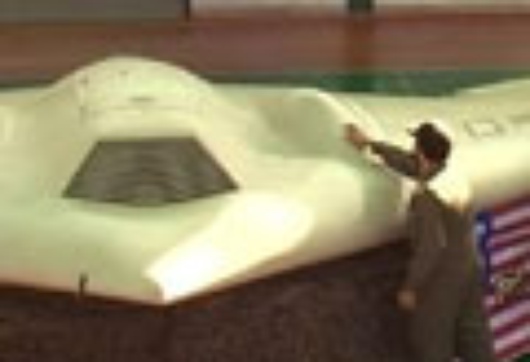
On Dec 8th 2011 Iran exhibited the top-secret US stealth drone RQ-170 Sentinel captured on Sunday, Dec. 4. Its almost perfect condition confirmed Tehran's claim that the UAV was downed by a cyber attack, meaning it was not shot down but brought in undamaged by an electronic warfare ambush. This is a major debacle for the stealth technology the US uses in its warplanes and the drone technology developed by the US and Israel. The state of the lost UAV refutes the US military contention that the Sentinel's systems malfunctioned. If this had happened, it would have crashed and either been wrecked or damaged. The condition of the RQ-170 intact obliges the US and Israel to make major changes in plans for a potential strike against Iran's nuclear program.
There is also some other risks than Iran's counter strike such as
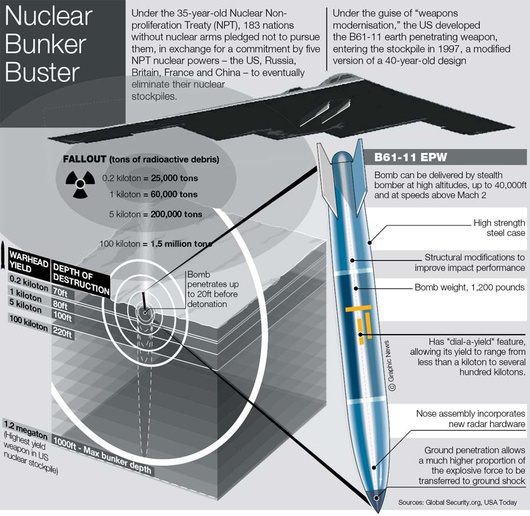 The
newest Iranian nuclear facilities are nearly 100 meter deep in hard
rock. The consequence is that to destroy this plant the most effective
bunker busters are needed maybe even a nuclear bomb some 1 megaton size.
Using so heavy methods can have their effect also outside Iran's
borders e.g in form of radioactive dust.
The
newest Iranian nuclear facilities are nearly 100 meter deep in hard
rock. The consequence is that to destroy this plant the most effective
bunker busters are needed maybe even a nuclear bomb some 1 megaton size.
Using so heavy methods can have their effect also outside Iran's
borders e.g in form of radioactive dust.
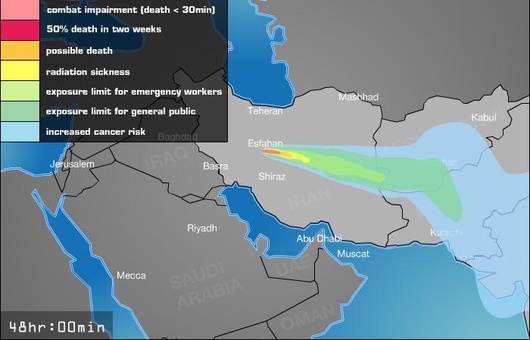
Position of Iran
Israel is unique in that it perceives a nuclear Iran as a potentially existential threat. The Iranian leadership has continuously threatened to “wipe Israel off the map” and with nuclear weapons they could also implement this aim. Given their collective memory of the Holocaust and the hostile surrounding in which they have had to defend themselves, Israelis take this threat especially seriously. A nuclear Iran would change radically regional or even geopolitical balance. It would increase the danger of miscalculation towards a nuclear crisis. Iran could take bolder position threatening Israel and moderate Arab regimes, undermining any Israeli-Arab peace process and manipulating the energy markets.
Dore Gold hits the core of the problem in his column published in IsraelHayom by asking Is Iran rational? One of the most difficult questions that the West needs to answer in the year ahead is whether Iranian behavior will be influenced mostly by rational considerations or by ideological beliefs. Some analysts say that the possession of nuclear weapons might encourage moderation in the Iranian regime ( Reuven Pedatzur in Haaretz on Dec. 20, 2011). The leading commentator on international affairs in the U.S., Fareed Zakaria, also believes that a nuclear Iran would act rationally and could be deterred. He notes that the Revolutionary Guard has become the center of power in Iranian decision-making taking, displacing the religious leadership.
Western intelligence has assessed that if Iran wanted to develop atomic bombs, it has the scientific, technical and industrial capacity eventually to do so. There might be not yet a consensus in Tehran that they actually want build a bomb, it is seen more like an open option for the future. So far the aim of in fact covert war has been to give Iran’s leaders a reason not to go nuclear weapons. However Iran might see this current policy opposite way, it could give Iran a reason to weaponise. So far the aim of in fact covert war has been to give Iran’s leaders a reason not to go nuclear weapons. However Iran might see this current policy opposite way, it could give Iran a reason to weaponise.
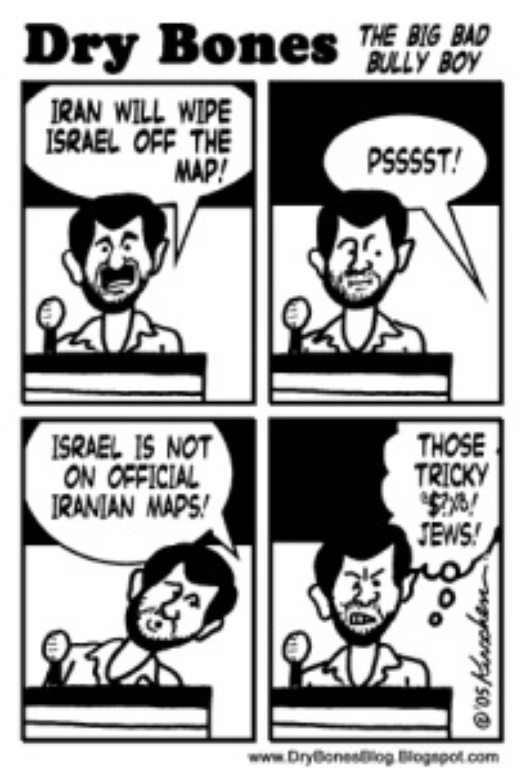 The
registration of candidates for the Majles elections slated for March 2,
2012 ended last weekend. Meanwhile, power struggles are still being
waged between the two major bodies affiliated with the conservative
bloc: the United Conservative Front, affiliated with President
Ahmadinejad’s political opponents, and the Stability Front of the
Islamic Revolution (Jebhe-ye Paydari), which consists of activists
considered to be the president’s allies. The Khabar Online website
reported this week that from among more than 1,000 candidates who
registered for the elections in Tehran Province, only about 60 are
well-known political personalities; and that 46% of the candidates are
affiliated with the United Conservative Front, 21% with the Stability
Front, and 7% with the reformist camp.
The
registration of candidates for the Majles elections slated for March 2,
2012 ended last weekend. Meanwhile, power struggles are still being
waged between the two major bodies affiliated with the conservative
bloc: the United Conservative Front, affiliated with President
Ahmadinejad’s political opponents, and the Stability Front of the
Islamic Revolution (Jebhe-ye Paydari), which consists of activists
considered to be the president’s allies. The Khabar Online website
reported this week that from among more than 1,000 candidates who
registered for the elections in Tehran Province, only about 60 are
well-known political personalities; and that 46% of the candidates are
affiliated with the United Conservative Front, 21% with the Stability
Front, and 7% with the reformist camp.
Will there be anything else than negative and more negative outcomes?
An alternative way to military option from my point of view – which might be too optimistic - is to boost of diplomacy and sanctions. After years of measures that had little impact, the new sanctions are the first that could have a serious effect on Iran's oil trade, which is 60 percent of its economy. Sanctions signed into law by U.S. President Barack Obama on New Year's Eve would cut financial institutions that work with Iran's central bank off from the U.S. financial system, blocking the main path for Iran to receive payments for its crude.
Following the announcement by the European Union that its member states will cease imports of Iranian crude oil, Japan said yesterday that it would also consider cutbacks in its purchases of Iranian oil. Also China has cut its purchases of Iranian oil by half this month, and is set to extend its cuts into February. The EU, China and Japan account for about half of the totality of Iranian exports of 2.6 billion barrels of oil per day. These new sanctions will have some economic effect in Iran but other sanctions might be needed.
Diplomacy must be done with various interests in mind. Iran has recently signaled that it is willing to restart talks with UN lead international community based 5+1 composition (=UNSC+Germany). The hope is that Iran will come around and allow IAEA inspectors to resume inspections. However, there always exists the possibility that Iran may use IAEA inspections as a way to buy time at sites unknown to the IAEA. If sanctions and diplomacy fail and proof of a nuclear weapons program is established, should the military option be seriously considered.
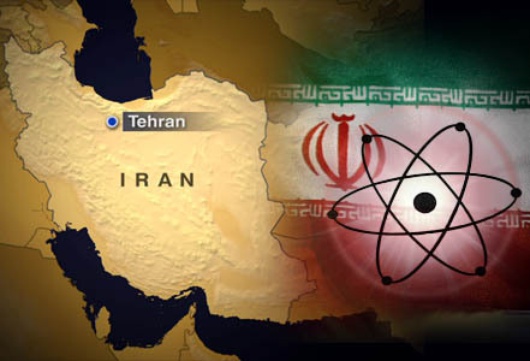 If
all non-military pressures fail there are clearly no “good” options
available. In my opinion it is hard to believe either side wants a war
to start because all sides are aware about risks. Today's preparations
for strike might be aimed to be means of pressure to get non-military
solution. However, when emotions are high, domestic political interests
differ in different key player states and massive destruction weaponery
is on the theatre the situation can escalate anytime.
If
all non-military pressures fail there are clearly no “good” options
available. In my opinion it is hard to believe either side wants a war
to start because all sides are aware about risks. Today's preparations
for strike might be aimed to be means of pressure to get non-military
solution. However, when emotions are high, domestic political interests
differ in different key player states and massive destruction weaponery
is on the theatre the situation can escalate anytime.


